#years active 1954-67
Note
New South Wales U set
Add article description
The U sets were a type of electric multiple unit (EMU) operated by the New South Wales Government Railways and its successors between September 1958 and November 1996. They were nicknamed U-boats.
Quick Facts U set, In service ...
U set
Preserved driving car CF 5003 at
Junee Roundhouse Railway Museum
Interior
In service
15 September 1958 – 1 November 1996
Manufacturer
Commonwealth Engineering
Built at
Granville
Constructed
1957–1960
Entered service
September 1958 – March 1960
Number built
40 motor cars
20 trailer cars
20 non-smoking trailer cars
Number in service
0
Number preserved
12 motor cars, 18 trailer cars (as at 2018)
Formation
4 car sets
Fleet numbers
CF 5001-40
TF 6001-20
ETB 6021-40
Operators
New South Wales Government Railways
Public Transport Commission
State Rail Authority
CityRail
Depots
Flemington Maintenance Depot
Lines served
Blue Mountains
Newcastle
Illawarra
Specifications
Car length
20.57 m (67 ft 5+7⁄8 in)
Width
2,950 mm (9 ft 8+1⁄8 in)
Height
3,920 mm (12 ft 10+3⁄8 in)
Maximum speed
70 mph (113 km/h)
Weight
49 long tons 8 cwt (110,700 lb or 50.2 t)
Traction system
4 Metropolitan-Vickers MV222 series-wound DC traction motors per motor coach, each rated at 180 hp, semi-automatic electro-pneumatic resistance control.
Transmission
74:17 Gear ratio. Helical gears. Wheel diameter 36 inch (914mm)
Power supply
120vDC
Electric system(s)
1,500 V DC catenary
Current collector(s)
Single-pan diamond pantograph
Braking system(s)
Westinghouse Brake & Signal Co electro-pneumatic and automatic air brakes, brake blocks active on all wheels
Coupling system
automatic coupling
Multiple working
MU capable in various formations
Track gauge
1,435 mm (4 ft 8+1⁄2 in) standard gauge
Close
Development
The New South Wales Government Railways began planning the electrification of the Main Western line over the Blue Mountains from 1949, and with that plan in full swing by the early 1950s, called tenders for 80 cars (40 motor, 20 trailer and 20 first with buffet trailer), with the contract was awarded to Commonwealth Engineering, Granville, in 1954. Electric traction equipment was supplied by the Metropolitan-Vickers, Manchester. However, before construction began the order was amended with the 20 planned first with buffet cars built as full first class seating cars, after a review of the New South Wales Government Railways conducted by American firm Ebasco Services Incorporated in the mid-1950s recommended the change.
The U sets were a bit different compared to the suburban single decked trains that were delivered at the same time. They were the first EMUs in NSW to feature stainless-steel construction using technology from the Budd Company, improving train acceleration and giving the trains lower maintenance costs and a longer usable life.
Delivery
The U Sets started to be delivered from June 1957, and the first sets made their first public appearances that same year. The first appearance took place on 22 June 1957 when they were hauled by electric locomotive 4625 as part of the first official electric train to travel on the newly electrified Blue Mountains line. Normal services began on 15 September 1958, and all were in service by March 1960.
The cars were numbered as:
Second-class motor cars: CF 5001-40
Second-class trailer cars: TF 6001-20
First-class (non-smoking) trailer cars: ETB 6021-40
First class travel was abolished on 1 September 1974. This saw the removal of the word "Second" on all carriages and also allowed non-first class passengers to enjoy the benefits of non-smoking carriages for the first time.
In service
The U sets initially entered revenue service on 15 September 1958 this being a Sydney Terminal to Mount Victoria service which was then known as "The Fish". The U sets initially operated on the Main Western line as far as Bowenfels which was the limit of the electrified system at the time. This was cut back to Lithgow in 1974. As the electrified network expanded they began to operate to Gosford (23 January 1960), Wyong (April 1982), Newcastle (June 1984), Port Kembla (February 1986) and Dapto (January 1993). The U sets were supplemented by V set double deck sets from 1970.
From the mid-1970s many had their original lift-up windows replaced by Beclawat sliding windows.
Withdrawal and preservation
Withdrawal of the sets began in 1994 as new Tangara G sets began replacing them. The first Tangara G sets entered service in June 1994 and as they were progressively put into service through to late 1995 the U sets were progressively withdrawn. The final run of the U sets on the Main Western Line for Blue Mountains services was in late February 1996 after which they only performed revenue services on the Northern Line between Sydney and Newcastle. The very last U Sets were withdrawn in early November 1996. The final revenue service performed by a U set was on Friday afternoon 1 November 1996 – a four car set operating a Newcastle to Sydney service. The cars on the final passenger service were CF5008 TF6004 TF6020 CF5008.
The final U set to run under its own power was a Sydney Electric Train Society Farewell tour two days later on the Sunday 3 November 1996 performed by an eight car set.
A number of U Set carriages have been preserved.:. Most of the cars allocated to the Hunter Valley Railway Trust were scrapped in 2013, excepting CF 5001. Richmond Vale Railway lost cars TF 6001/02 and ETB 6026 in a bushfire in 2017.
A preserved U set appeared in Guy Sebastian's "Standing with You" music video in 2020.
The NSW State-Owned Heritage Collection, managed by Transport Heritage NSW, has five U set carriages (CF5015, CF5017, CF5035, TF6013 & ETB6029) preserved and in custody of Historic Electric Traction who are currently restoring heritage U set "U2" to operational condition at Redfern.
Sydney Electric Train Society has CF5003 & CF5021 (stored at Lithgow) and CF5001, CF5022, TF6010 & ETB6037 (stored on a private property).
Valley Heights Rail Museum has ETB6039 on static display.
Dorrigo Steam Railway & Museum has CF5004 & CF5024 on static display.
Richmond Vale Railway Museum has TF6008, TF6009, TF6011, TF6012 & TF6019 stored.
-girl who sent the t and k sets
some more interesting reading from the train girl! I love these
1 note
·
View note
Text
“The FFWPU/UC's way of doing things is to pretend to care so it can use follower’s troubles against them.”
Husband who helped wife leave Unification Church now supports others
KYODO NEWS, Japan – August 7, 2022
Groups working to persuade individuals to leave the Unification Church say they face a daunting task as "they must beat God."
The fatal shooting of former Japanese Prime Minister Shinzo Abe during a campaign stump speech last month in the western city of Nara has led to a surge in people reaching out to groups that help members of the church and their families, with one group reporting Thursday a 12-fold rise in consultations from June to July.
Among those providing support is Akira, 64, and his 67-year-old wife Kyoko, a former member of the church. The couple spoke to Kyodo News under pseudonyms about how he convinced her to leave the church.
The Unification Church, now formally known as the Family Federation for World Peace and Unification, was founded in 1954 in South Korea by a staunch anti-communist. It has come under renewed attention since investigative sources revealed that the assailant claims to have shot Abe because of his alleged links to the church.
The accused, Tetsuya Yamagami, 41, has also said his mother's membership of the church and large donations to it bankrupted the family. Known for its mass weddings, the church had previously drawn scrutiny over so-called spiritual sales, in which people are talked into buying jars and other items for exorbitant prices.
For Kyoko and Akira, their relationship with the church began in July 1997, when another mother at their son's school invited her to a study session to learn about their family tree. The seminar, held in an apartment, was attended by about 30 people.
Apart from ancestry, Kyoko also enjoyed speaking to the woman about other matters, including her relationship with her husband, worries about raising her son and her relatives.
For Kyoko, it felt like she had found a safe space, somewhere she could talk and be listened to when bringing up things she could not discuss at home.
As she attended more meetings, Kyoko started to ask those present about the meaning of events in her life. Each time she received an explanation of what her experiences signified, she came away with a sense of satisfaction.
She started going to the meetings every week. When it was revealed to her in November of that year that the group was actually part of the Unification Church she was not deterred.
It was around this time that Akira realized his wife had become a follower. He confronted her after finding a book produced by the church in their home.
“I couldn't understand his concern and we fought daily,” Kyoko said.
Akira eventually decided to change tack and start trying to find ways to empathize with his wife. Attending gatherings for people who had left the church and their families changed his thinking.
Although Kyoko clung to her belief that leaving the church would result in damnation, he did not give up. She finally left the church in June 1999, about a year and half after Akira first started trying to persuade her to get out.
But what changed her mind was not anything he said. It was someone who had left the church.
“This person who had experienced the same thing said, 'I'm glad I left.' I thought for the first time that, even though I had always been scared of the idea, maybe it would be all right if I did quit,” Kyoko said.
Starting in 2003, Akira joined up with people he had come to know through activities aimed at helping followers to leave the church and established a group to support the families of members.
“The church's way of doing things is to pretend to care so it can use follower’s troubles against them. To bring back a significant person in your life, the most important thing is to not dismiss them and to believe in yourself,” he said.
#Unification Church#cult#Hak Ja Han#Sun Myung Moon#FFWPU#unification church in japan#japanese church#ex-members#ex-moonies
0 notes
Text
August Eridanids
This somewhat diffuse radiant was noted while examining the 39,145 radio meteor orbits obtained by Z. Sekanina during the Radio Meteor Project of the 1960s. Six radio meteors were identi fi ed which suggested a duration of August 2–27. Maximum seems to occur around August 11/12 from an average radiant of August Eridanids 187 a = 49.6°, d = −4.9°. What makes this stream orbit especially interesting is its similarity to the orbit of periodic comet 273P/Pons-Gambart. The orbits of the radio meteors and comet are shown below.
No visual evidence exists to directly support this radiant; however, there is strong evidence of activity 8–10° north among the records of the American Meteor Society (AMS) and the radiants published by C. Hoffmeister in his 1948 book Meteorströme . Among the AMS records, the most interesting are those of C. E. Worley (California, USA), when he saw activity from this radiant on three consecutive nights in 1954. He plotted fi ve meteors from a = 45.0°, d = +4.8° on August 7.4, 5 meteors from a = 48.0°, d = +1.5° on August 8.4, and 7 meteors from a = 48°, d = +2° on August 9.4. 67 The earliest observed radiant from this stream came from H. L. Alden (Virginia, USA), when he recorded three meteors from a = 45.0°, d = +4.8° on 1926 August 11.7. 68 Additional AMS radiants were reported in 1929, 1941, and 1958. Among the list of 5,406 German radiants compiled by Hoffmeister, are three additional radiants which possess positions similar to those reported by the AMS. They were detected from 1937 August 8 to 19, while Hoffmeister was observing from South-West Africa (now Namibia). By combining these radiants with those of the AMS, the following parabolic orbit has been computed.
The potential separation between the radio-echo data and the visual data could indicate that the August Eridanids are very old, indicating that mass separation has occurred. Comet Pons-Gambart was seen for a month in 1827. Although its orbital period was determined as 57.5 (with a probable error of ±10 years) it was considered lost after attempts to fi nd it failed. It was accidentally rediscovered in 2012 November. The precise positions quickly allowed a link to the 1827 apparition and revealed that the orbital period was actually 188 years.
0 notes
Photo
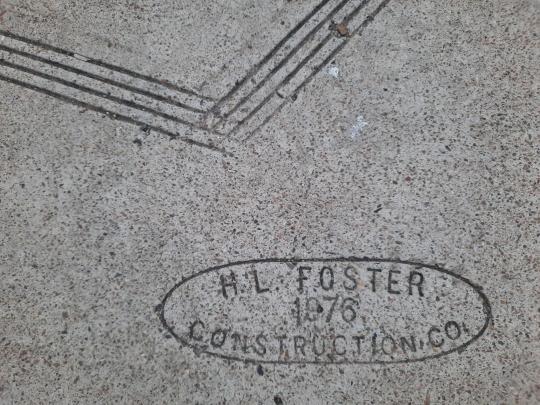
H. L. Foster Construction Co. 1976 (Photo taken by Rachel Hughes in San Diego, CA)
This is a family dynasty started by Henry L. Foster, Sr. with his wife and oldest son in 1975. The company incorporated October 24, 1977 and was listed in the Official Directory, Licensed Contractors of California: 1977-79. They also took out an ad in Judges, Marshals and Constables Magazine, listing themselves as a “General Engineering Contractor, Asphalt & Concrete Specialist” with license number 302582 (p. 34, Volume 39. Judges, Marshals and Constables Association, 1979).
Sr’s hometown was Macon, Georgia, but he left with his wife, Emma Doris Smith Foster, and four children and “five dollars in their pockets” for California “in pursuit of their dream of racial equality and prosperity for their young family.” They “soon became one of the first African American families to purchase a home in the Valencia Park community of San Diego where they raised their five children.” Sr. also played semi-professional baseball and built baseball fields in the community. Sadly, Sr. died in 1986 or 1987. His body was found “in a canyon area of Scripps Ranch” in January 1987, but he was last seen alive in December of 1986 at a bowling alley. “The site where the 55-year-old victim was found is a steep ravine with loose gravel, and police said it was possible that Foster died from a fall.“ However, his daughter believed that “her father was abducted, robbed and then killed.” (“San Diego.” Los Angeles Times, 29 Jan. 1987, www.latimes.com/archives/la-xpm-1987-01-29-me-1987-story.html.) I couldn’t find anything that would tell me if they ever found out what happened!

Henry Louis Foster Jr. was born February 9, 1954 in Atlantic City, New Jersey and died February 18, 2021 at age 67. He was called Butch by his family and friends and was married to Elena Leavy, whom he married in high school. After graduating from San Diego City College, he joined his father in the construction business. According to an obituary, he “played a vital role in hiring many people of color in the construction industry giving them their first union job” and was “an active member of the Labors’ Union of North America, Local 89... until he retired.” (www.andersonragsdalemortuary.com/obituary/Henry-FosterJr.)
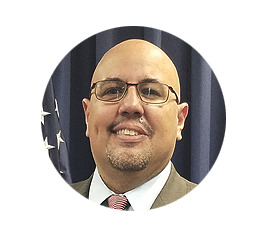
Henry L. Foster III, is the Chief of Staff for San Diego City Council President Pro Tem Monica Montgomery Steppe (District 4) and “has over 25 years of experience in the construction industry,” having “completed a variety of construction projects totaling over $1B of work in place.” Before working for the city, he worked for many different construction companies (www.sandiego.gov/citycouncil/cd4/staff/hfoster). He was Jr.’s oldest child and has two siblings.
0 notes
Photo
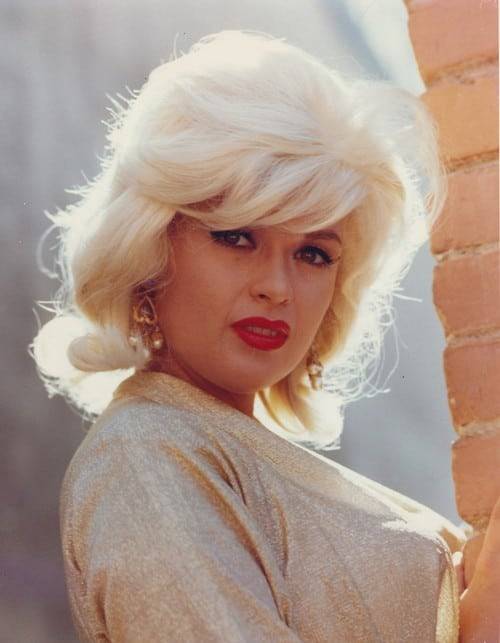

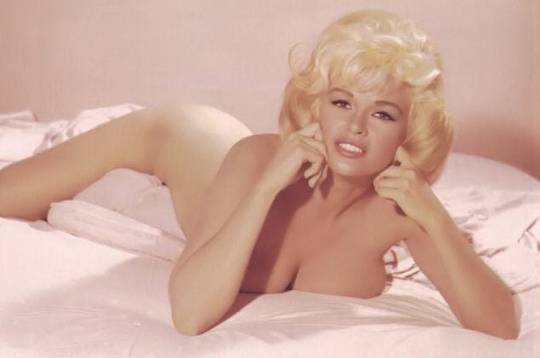




Happy Birthday To The One And Only Beautiful American Actress
Jayne Mansfield (Born 19th April 1933)
Pics Source: Listal.com
Gif Source: Bing Images
(No.50-56)
#jayne mansfield#birthday girl#born 19th april 1933#beautiful american actress#the one and only#pin up model#trade marks: platinum blonde hair - voluptuous figure - lispy breathless voice#playboy's playmate of the month february 1955#best remembered for her roles in the girl can't help it (1956) - will success spoil rock hunter (1957) - too hot to handle (1960)#only 35 acting credits#years active 1954-67#old hollywood#pics source: listal.com#gif source: bing images
71 notes
·
View notes
Text
CJ current events 9fed22
Catholic sex abuse
Clergy sex abuse in the Catholic Church is not “over.” I mean this in two ways.
First, some clergy sexual abuse is undoubtedly still taking place. But more importantly, we haven’t really dealt with the situations we already have experienced. Investigating the allegations, sending the guilty to prison, Church officials making amends to the victims, including financial payments — all this is important. But we as the larger Church community need to face the larger fact: A problem like childhood sexual abuse has many layers. Each incident affects numerous people, including family members and the parish or school community. We aren’t “done,” we haven’t “solved” clergy sex abuse, until we deal with all these social, emotional, and spiritual issues, along with the legal and financial issues.
Before I unpack all that, though, let’s recap some of the statistics. A look at the data will show beyond any shadow of a doubt that, although clergy sex abuse has declined in the Catholic Church, it isn’t gone.
My colleague Father Paul Sullins systematically analyzed data on clergy sexual abuse in two separate reports***

He found data that suggests the problem has shifted. Recent victims are more evenly divided between male and female, instead of the preponderance of male victims from earlier times. Importantly, the age of the victims has shifted toward older victims: There are fewer pre-pubescent victims and more teenage victims today. He did find some hopeful news, which suggests the problem has improved. Recent data shows fewer reported cases among younger, recently ordained priests.*** https://www.ncregister.com/commentaries/20-years-after-the-dallas-charter-has-catholic-clergy-sex-abuse-been-solved
+++
Pope emeritus Benedict XVI personally requested forgiveness from abuse survivors on Tuesday in a letter responding to a report that faulted his handling of cases during his tenure as Munich archbishop from 1977 to 1982.
In an almost 1,000-word letter released on Feb. 8, the 94-year-old retired pope said that his pain was all the greater as he had “borne great responsibility in the Catholic Church,” reported CNA Deutsch, CNA’s German-language news partner.***
Concluding his letter, Benedict, who turns 95 on April 16, looked ahead to his judgment before God.
“Quite soon, I shall find myself before the final judge of my life. Even though, as I look back on my long life, I can have great reason for fear and trembling, I am nonetheless of good cheer, for I trust firmly that the Lord is not only the just judge, but also the friend and brother who himself has already suffered for my shortcomings, and is thus also my advocate, my ‘Paraclete,’” he wrote.
“In light of the hour of judgment, the grace of being a Christian becomes all the more clear to me. It grants me knowledge, and indeed friendship, with the judge of my life, and thus allows me to pass confidently through the dark door of death.”
“In this regard, I am constantly reminded of what John tells us at the beginning of the Apocalypse: he sees the Son of Man in all his grandeur and falls at his feet as though dead. Yet He, placing his right hand on him, says to him: ‘Do not be afraid! It is I…’” https://www.catholicnewsagency.com/news/250319/benedict-letter-munich-sexual-abuse-report-analysis
***
In all fairness, it's only been 67 years since Brown v. Board of Education, 347 U.S. 483 (1954)
A Massachusetts school district entered into a settlement agreement with a parent activist group that had sued it for holding a series of racially segregated activities.
Parents Defending Education had sued Wellesley Public Schools for holding the racially segregated activities last year. In the newly announced settlement agreement, the district agreed to never hold them again.*** https://www.washingtonexaminer.com/policy/massachusetts-school-district-ends-racially-segregated-groups-after-lawsuit
***
78-year-old great-grandfather arrested and handcuffed by Ottawa Police 6feb22
https://youtu.be/Ea-7RKpRNIk about 2:20
Gerry Charlebois honked the horn in his mini-van.
***
Thanksgiving may be a little awkward
Two children of a Texas member of the Three Percenter militia group are expected to testify against their father this month in a Capitol riot trial, according to a witness list from the Justice Department.
Jackson, 19, and Peyton Reffitt, 17, are expected to testify that Guy Wesley Reffitt, who is facing charges related to his actions on Jan. 6, threatened them not to cooperate with the FBI's investigation, insisting that "they would be traitors, and that traitors get shot," according to federal prosecutors in a Monday court filing reported by Politico.
Jackson will also testify about a threat his father made to him after returning from Washington, D.C., "about cooperating with the FBI's investigation," prosecutors said.
Several pieces of evidence admitted include group texts his father sent while he was away with a link to a Fox News segment circling himself in videos and an audio recording of his father in their home around Jan. 9-10.*** https://www.washingtonexaminer.com/news/justice/prosecutors-say-three-percenters-children-will-testify-against-him-in-capitol-riot-trial
***
Always use a Guardian Angel
St. Louis couple Mark and Patricia McCloskey, who gained national attention in 2020 for standing outside their home toting guns as protesters walked by, were placed on probation as lawyers Tuesday.
The Missouri Supreme Court ruled to suspend the McCloskeys' law licenses but opted to delay the suspension and instead put them on probation for a year, as reported by the St. Louis Post-Dispatch. Under probation, the two will still be allowed to practice law.*** https://www.washingtonexaminer.com/news/missouri-supreme-court-places-mark-and-patricia-mccloskey-on-probation-as-lawyers
***
Where TF does Lord Humungous live?????


****
sick
BATON ROUGE, La. (WAFB) - Attorneys for Cynthia Perkins filed a motion for change of venue Tuesday, Feb. 8, 2022.
According to the court documents, attorneys for Perkins say she is entitled to the change of venue based on widespread media coverage and pretrial publicity and the right to a fair trial will be in jeopardy if she were to face trial in Livingston Parish.
Cynthia Perkins, along with her husband, former Livingston Parish sheriff’s deputy Dennis Perkins, is accused of a number of charges including rape, producing child pornography, and participating in feeding desserts laced with his semen to school children.*** https://www.kalb.com/2022/02/08/attorneys-cynthia-perkins-file-motion-change-venue/
***
2 notes
·
View notes
Text
MARILYN MONROE
June 1, 1926 - August 4, 1962
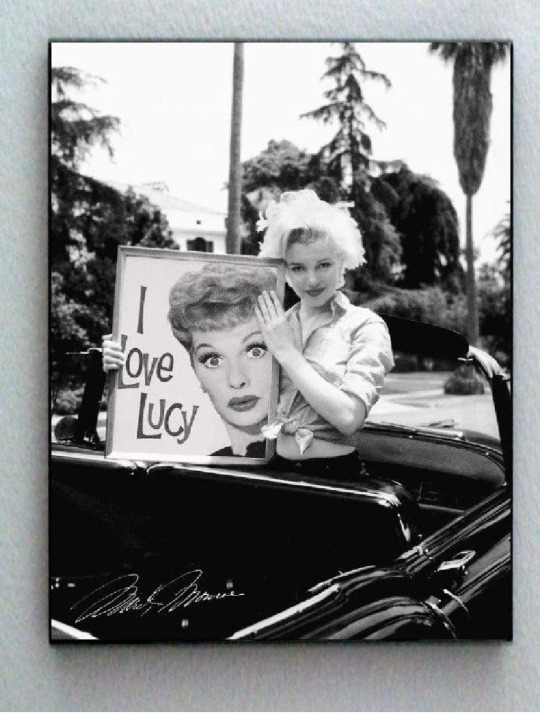
Marilyn Monroe (born Norma Jeane Mortenson) was an actress, model, and singer. Famous for playing comedic "blonde bombshell" characters, she became one of the most popular sex symbols of the 1950s and early 1960s and was emblematic of the era's changing attitudes towards sexuality. She was a top-billed actress for only a decade, but her films grossed $200 million by the time of her death in 1962. More than half a century later, she continues to be a major popular culture icon.
"When I was five I think, that's when I started wanting to be an actress. I didn't like the world around me because it was kind of grim, but I loved to play house. When I heard that this was acting, I said that's what I want to be. Some of my foster families used to send me to the movies to get me out of the house and there I'd sit all day and way into the night. Up in front, there with the screen so big, a little kid all alone, and I loved it.” ~ Marilyn Monroe,1962

Lucille Ball never worked with Marilyn Monroe, but meet her in 1953 at Ciro’s Nightclub on Sunset Strip, along with Betty Grable, and Red Skelton. Monroe’s immense popularity permeated Ball’s work none-the-less.
At the start of “Changing the Boys’ Wardrobe” (ILL S3;E10) the gang is heading to the movies to see “That picture we’ve been trying to get to for weeks with Marilyn Monroe.” The movie is likely Gentlemen Prefer Blondes, which premiered in New York City in July 1953. On November 5, 1953, the same day the episode was filmed, Monroe’s new film How to Marry a Millionaire was released in the US.
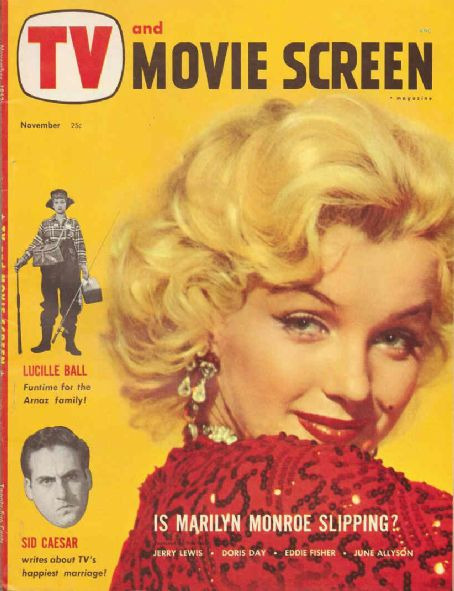
The November 1953 cover of TV and Movie Screen Magazine saw Lucy (in “The Camping Trip”) and Marilyn wearing the dress she wore on the May 1953 cover of Life Magazine promoting Gentlemen Prefer Blondes.

Also on November 5, 1953, the town of Monroe, New York (60 miles from New York City) was temporarily renamed Marilyn Monroe.

The film later inspired much of the plot of “Second Honeymoon” (S5;E14), Lucy’s failed attempt to make their transatlantic crossing to Europe more than just a working vacation.

Monroe’s dinner companion turns out to be a seven year-old boy, just like Lucy’s ping pong partner turns out to be young Kenneth Hamilton (Harvey Grant).
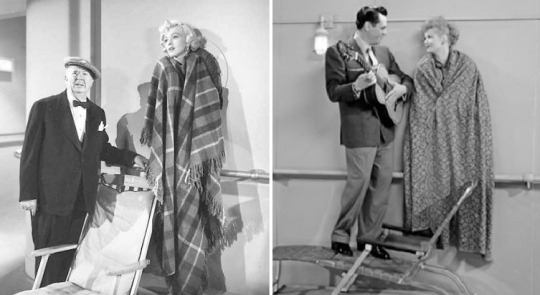
Lucy gets stuck in a porthole just as Monroe did, also draping a blanket around her shoulders so passersby wouldn’t know what was really going on.

The idea for the burlap potato sack dresses in “Lucy Wants A Paris Gown” (ILL S5;E20) comes from Monroe’s real life.

In 1951 Marilyn Monroe took a series of high fashion photographs wearing a potato sack as a response to a journalist who said that she might look sexier in a burlap sack than her usual fashion choices.

Lucy first wore burlap at the end of “Mr. and Mrs. TV Show” (ILL S4;E24) as her scary version of a Phipps make-over.

In “Ricky’s Movie Offer” (ILL S4;E5) Lucy and Ethel argue about who looks more like Marilyn Monroe.
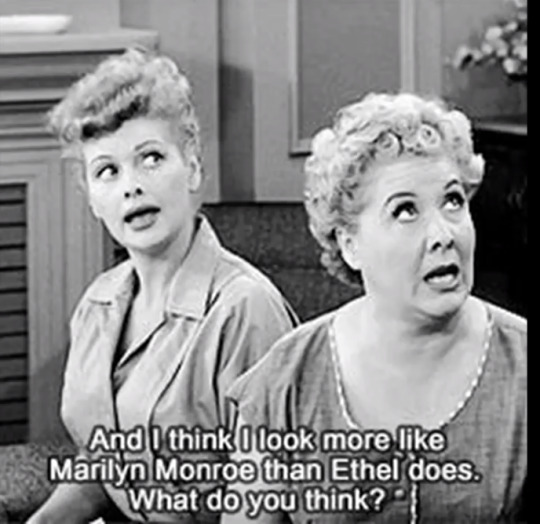
While Lucy has the facial features, Ethel has the blonde hair.

Fred (hilariously) settles the argument!

In “Ricky’s Screen Test” (ILL S4;E7) a long list of Hollywood names are dropped in anticipation of hobnobbing with celebrities, including Marilyn Monroe.
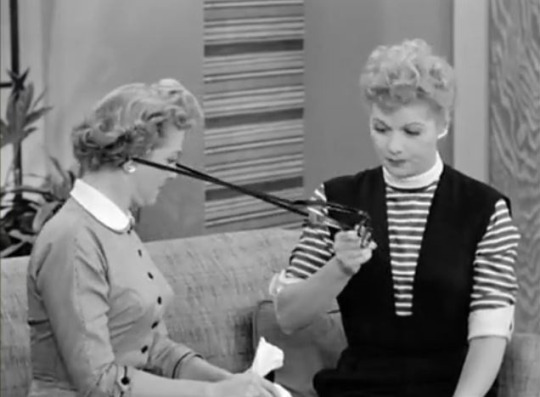
In “Lucy and Harpo Marx” (ILL S4;E28) Lucy wonders if Ethel might pass for Monroe to a near-sighted Carolyn Appleby. After Ethel tries to walk like Marilyn Monroe, Lucy decides that “nobody is that near-sighted!” Fred says that he looks more like Marilyn than either of them!
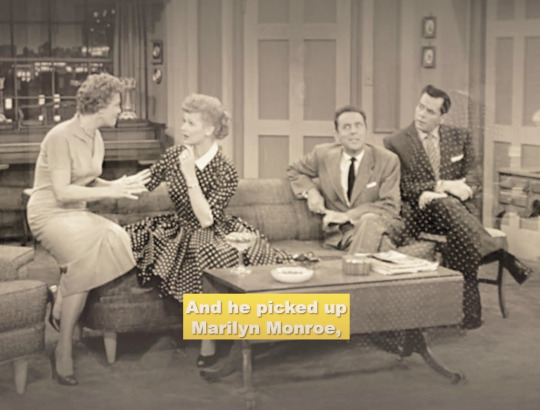
In “Lucy and Superman” (ILL S6;E13), the Appleby’s come over for a social evening that Ethel calls “the bore war” because the couples only talk about their children. As the scene opens, Caroline is in mid-sentence talking about a Marilyn Monroe film.
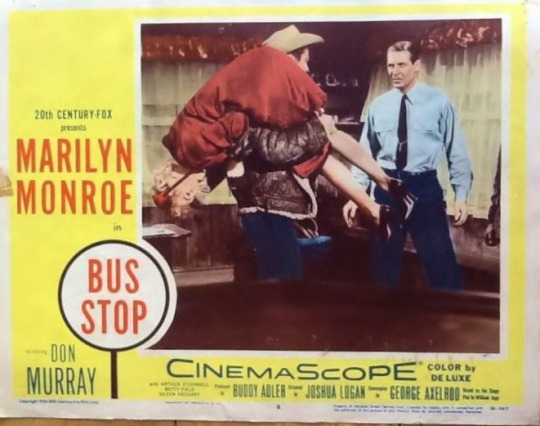
CAROLINE: “...and he picked up Marilyn Monroe, slung her over his shoulder and carried her off!”
Although the title is never mentioned, the film they are discussing is Bus Stop, starring Marilyn Monroe and Don Murray. It was released in August 1956, two and a half months before this episode was filmed.

When “Lucy Does the Tango” (ILL S6;E20), she stuffs eggs down her blouse and Ethel stashes a some in her back pockets. Lucy tells her, “Whatever you do don’t try to walk like Marilyn Monroe,” but the ‘yolk’ is on Ethel when Fred suddenly enters through the kitchen door!
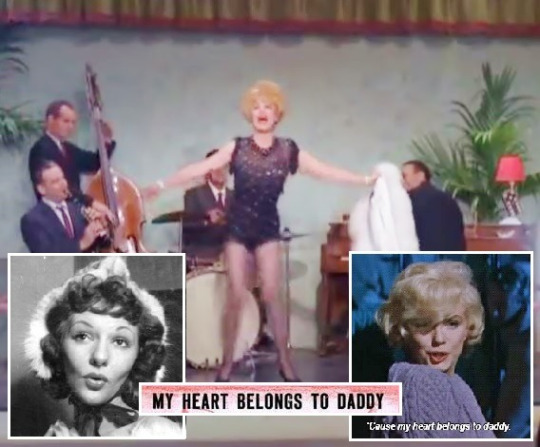
In “Lucy the Gun Moll” (TLS S4;E25), Lucy plays Lucy Carmichael and Rusty Martin. The name Rusty Martin was probably derived from Lucy’s hair color and the surname of Mary Martin, who introduced the song “My Heart Belongs to Daddy” (music and lyrics by Cole Porter) in the 1938 Broadway musical Leave It to Me. Marilyn Monroe sang it in the 1960 film Let’s Make Love. In that same film, Harry Cheshire, who played Sam Johnson in “Oil Wells” (ILL S3;E18), played Monroe’s father. Jerry Hausner (Jerry, Ricky’s Agent) and Joan Banks (Reporter Eleanor Harris in “Fan Magazine Interview”) played uncredited supporting roles.
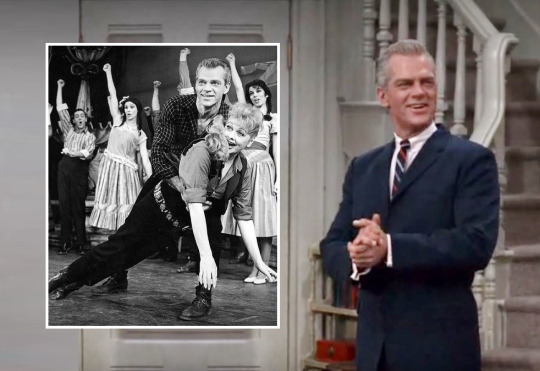
Lucy and Marilyn shared a leading man in handsome Keith Andes. Andes was Lucy’s male lead in Wildcat on Broadway, and later played was featured on three episodes of “The Lucy Show.”
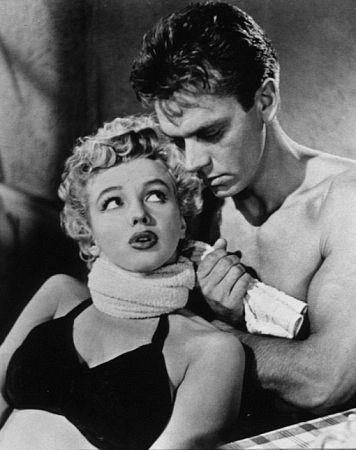
In 1952, he played opposite Marilyn in Clash By Night, an RKO picture.

In “Lucy Gets Ricky on the Radio” (1952), the June 3, 1952 of Look Magazine actually had Lucille Ball and Marilyn Monroe on the cover! Monroe was promoting Clash by Night, and Desi had written a feature on his wife for the magazine. So Marilyn actually did appear on “I Love Lucy” - if only in a still photo.
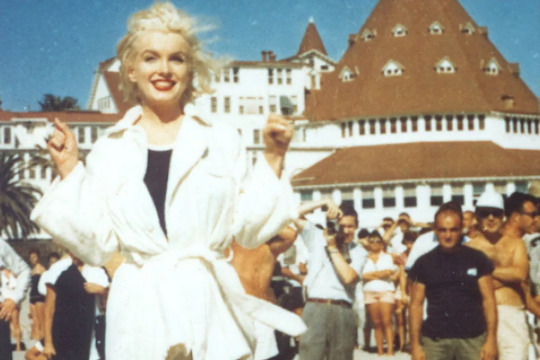

Some Like It Hot (1959) is arguably one of Marilyn Monroe’s most popular films. What does it have in common with Lucille Ball? In 1958, both Lucy and Monroe were depicted at San Diego’s famous Del Coronado Hotel. It is the hotel that the Ricardo’s and Mertzes stay at in “Lucy Goes to Mexico” (LDCH S2;E1) as well as the backdrop for much of the film. Although Desilu filmed establishing footage of the hotel, the cast stayed in Hollywood, while Monroe went on location (as seen above). In “Lucy Goes to a Hollywood Premiere” (TLS S4;E20), Mr. Mooney says he wouldn’t buy a second hand nightie if it had been worn by Jack Lemmon in Some Like It Hot.

The Irving Berlin song “There’s No Business Like Show Business” was sung on “I Love Lucy” and “The Lucy Show.” Although it was originally from the Broadway musical Annie Get Your Gun (1946), it also served as the title and was performed (by Merman) in the Marilyn Monroe film There’s No Business Like Show Business in 1955.

In 1952, Marilyn co-starred by Richard Widmark (”The Tour” ILL S4;E30) in the film noir drama Don’t Bother To Knock. The film also featured “Lucy” players Lurene Tuttle (Fine Arts League President), Verna Felton (Mrs. Porter), Gloria Blondell (Grace Foster), as well as Harry Bartell, Olan Soule, Robert Foulke, and Bess Flowers.
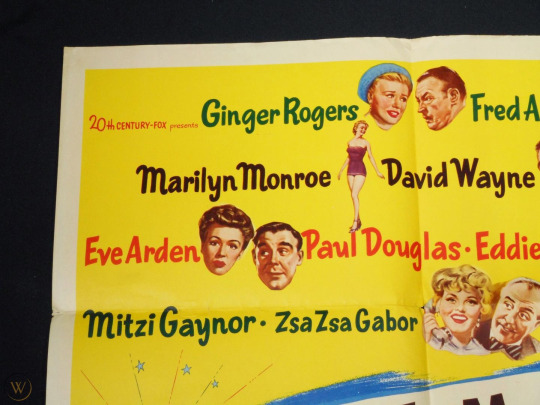
That same year, Monroe starred in We’re Not Married! opposite Lucy’s friend and former co-star Ginger Rogers, as well as Eve Arden (”Hollywood at Last!”), Paul Douglas (”Lucy Wants a Career”) and Eddie Bracken (Too Many Girls).
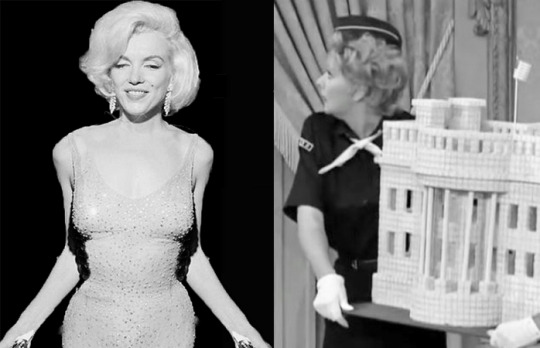
One of Monroe’s most iconic moments came in March 1962 when she sang “Happy Birthday” as a birthday present to President John F. Kennedy in a public birthday celebration also attended by Lucy’s friends and co-stars Jack Benny, Jimmy Durante, Henry Fonda, Danny Kaye, Shirley MacLaine and Elliott Reid. A year later, Lucy Carmichael also gave Kennedy a present, a sugar cube replica of the White House on “The Lucy Show” with Elliott Reid doing Kennedy’s offstage voice as well as playing a small on-camera role!
"I never quite understood it, this sex symbol. I always thought symbols were those things you clash together! That's the trouble, a sex symbol becomes a thing. I just hate to be a thing. But if I'm going to be a symbol of something I'd rather have it sex than some other things they've got symbols of." ~ Marilyn Monroe, 1962
Monroe was married (and divorced) three times:
James Dougherty, Merchant Marine & Policeman (1942-46)
Joe DiMaggio, Baseball Player (1954-55)
Arthur Miller, Playwright (1956-61)

In “Lucy is Enceinte” (ILL S2;E10), Fred gives Lucy a signed baseball for his future 'godson’. When he asks Lucy to read out the signature, she at first says “Spalding,” the ball’s brand name, but then finds it is signed by Joe DiMaggio.

In “Ragtime Band” (ILL S6;E21), Little Ricky asks his Uncle Fred:
LITTLE RICKY: “Who’s Joe 'Maggio?”
FRED: “'Who’s Joe 'Maggio?’ You talk more like your father everyday.”

In “Sales Resistance” (ILL S2;E17), Lucy compares herself to Willy Loman, the title character in Death of a Salesman, a Pulitzer Prize-winning play by Arthur Miller first produced on Broadway in 1949 and made into an Oscar-nominated film in 1951.
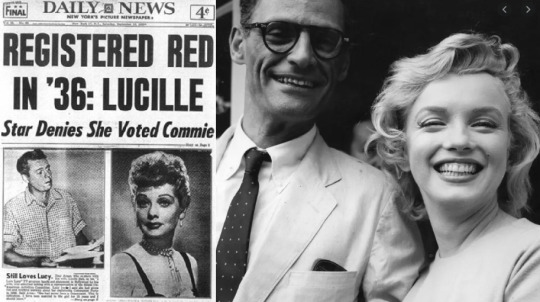
Speaking of husbands, Desi Arnaz has something in common with Marilyn Monroe, too. Both of their souses were accused of being Communists by the House Un-American Activities Committee during the 1950s. Both Lucille and Arthur Miller were cleared of charges and their careers continued, although that was not true for many celebrities of the time.
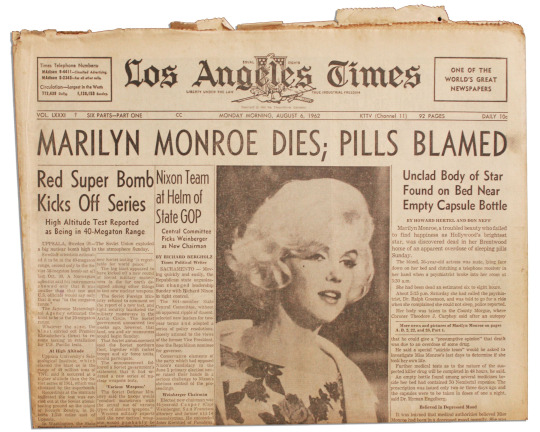
Monroe died on August 4, 1962. The toxicology report showed that the cause of death was acute barbiturate poisoning. Empty medicine bottles were found next to her bed. The possibility that Monroe had accidentally overdosed was ruled out because the dosages found in her body were several times over the lethal limit.

The character of Ginger, the movie star castaway on “Gilligan’s Island” (1964-67) was described during casting as a combination of Lucille Ball and Marilyn Monroe. Tina Louise had Lucy’s red (ginger) hair and Monroe’s shapely physique. The series also featured Natalie Schafer (Phoebe Emerson) as Mrs. Howell, and Alan Hale Jr. as the Skipper. Hale performed on “The Lucy Show” and “Here’s Lucy”. Series creator Sherwood Schwartz was a Lucy fan. His brother Elroy Schwartz actually wrote scripts for Lucille Ball.

In the 2013 web-series “Ryan & Ruby” both Lucille Ball and Marilyn Monroe are given special thanks for their inspiration. The last name of star and creator Ryan Burton's character is "Carmichael", the same as Ball's character on the "The Lucy Show". In Ryan’s kitchen there are fridge magnets with photos of both Lucy and Marilyn.
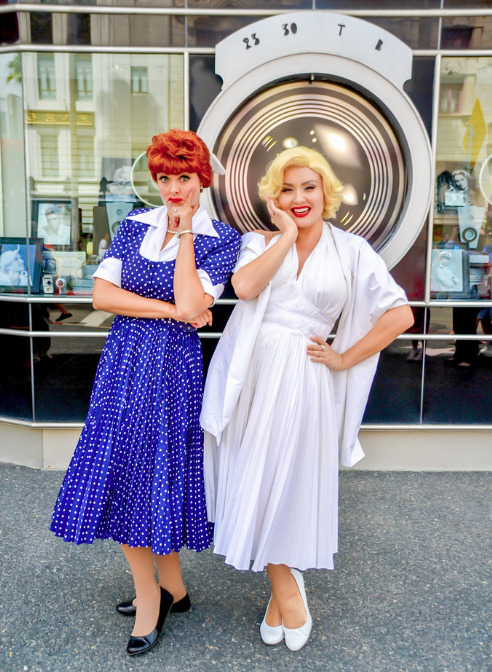
Lucy and Marilyn are street characters at Universal Studios theme parks, their iconic hair and costumes making them instantly recognizable.
The same day Marilyn Monroe was born in 1926, another Hollywood icon with connections to Lucille Ball was also born, Andy Griffith. To read his birthday blog, click here!
#Marilyn Monroe#Lucille Ball#I Love Lucy#William Frawley#Desi Arnaz#vivian vanc#the lucy show#Ryan and Ruby#Gilligan's Island#Tina Louise#Arthur Miller#Joe DiMaggio#Keith Thibodeaux#Alan Hale Jr.#natalie schafer#John F. Kennedy#Paul Douglas#Eve Arden#Ginger Rogers#Verna Felton#Ethel Merman#Richard Widmark#There's No Business Like Show Business#Hotel Del Coronado#Don't Bother To Knock#Some Like It Hot#Look Magazine#Keith Andes#Clash By Night#The Seven Year Itch
47 notes
·
View notes
Text
National Basketball Association
The National Basketball Association (NBA) is an American men's expert nba basketball alliance. It is made out of 30 groups (29 in the United States and 1 in Canada) and is one of the four significant pro athletics alliances in the United States and Canada. It is the head men's expert basketball alliance on the planet.

The alliance was established in New York City on June 6, 1946, as the Basketball Association of America (BAA).It changed its name to the National Basketball Association on August 3, 1949, in the wake of converging with the contending National Basketball League (NBL). The NBA's normal season runs from October to April, with each group playing 82 games. The group's season finisher competition reaches out into June. Starting at 2020, NBA players are the world's best paid competitors by normal yearly compensation per player.
The NBA is a functioning individual from USA Basketball (USAB),which is perceived by the FIBA (International Basketball Federation) as the public overseeing body for basketball in the United States. The alliance's few global just as individual group workplaces are coordinated off of its mind workplaces in Midtown Manhattan, while its NBA Entertainment and NBA TV studios are coordinated out of workplaces situated in Secaucus, New Jersey.
The NBA is the third wealthiest pro game group after the NFL and the MLB by income.
Creation and BAA–NBL merger (1946–1956)

The Basketball Association of America was established in 1946 by proprietors of the significant ice hockey fields in the Northeastern and Midwestern United States and Canada. On November 1, 1946, in Toronto, Ontario, Canada, the Toronto Huskies facilitated the New York Knickerbockers at Maple Leaf Gardens, in a game the NBA currently alludes to as the main game played in NBA history. The principal bushel was made by Ossie Schectman of the Knickerbockers. Despite the fact that there had been before endeavors at proficient basketball classes, including the American Basketball League and the NBL, the BAA was the principal association to endeavor to play essentially in enormous fields in significant urban areas. During its initial years, the nature of play in the BAA was not essentially better than in contending associations or among driving free clubs, for example, the Harlem Globetrotters. For example, the 1948 ABL finalist Baltimore Bullets moved to the BAA and won that group's 1948 title, and the 1948 NBL champion Minneapolis Lakers won the 1949 BAA title. Before the 1948–49 season, nonetheless, NBL groups from Fort Wayne, Indianapolis, Minneapolis, and Rochester hopped to the BAA, which set up the BAA as the association of decision for collegians hoping to turn proficient.
On August 3, 1949, the remaining NBL groups Syracuse, Anderson, Tri-Cities, Sheboygan, Denver, and Waterloo–converged into the BAA. In concession to the merger and to maintain a strategic distance from conceivable lawful entanglements, the alliance name was changed to the current National Basketball Association, despite the fact that the combined class held the BAA's overseeing body, including Maurice Podoloff as president. Right up 'til today, the NBA claims the BAA's history as its own. It presently figures the appearance of the NBL groups as an extension, not a merger, and doesn't perceive NBL records and measurements.
The new alliance had seventeen establishments situated in a blend of huge and little urban areas, just as huge fields and littler exercise rooms and arsenals. In 1950, the NBA solidified to eleven establishments, a cycle that proceeded until 1953–54, when the alliance arrived at its littlest size of eight establishments: the New York Knicks, Boston Celtics, Philadelphia Warriors, Minneapolis Lakers, Rochester Royals, Fort Wayne Pistons, Tri-Cities Blackhawks, and Syracuse Nationals, all of which stay in the group today. The cycle of compression saw the association's littler city establishments move to bigger urban communities. The Hawks moved from the Tri-Cities to Milwaukee in 1951, and afterward to St. Louis in 1955. The Rochester Royals moved from Rochester, New York, to Cincinnati in 1957 and the Pistons moved from Fort Wayne, Indiana, to Detroit in 1957.
Japanese-American Wataru Misaka broke the NBA shading obstruction in the 1947–48 season when he played for the New York Knicks. He remained the main non-white part allied history before the primary African-American, Harold Hunter, marking with the Washington Capitols in 1950. Tracker was cut from the group during instructional course, yet a few African-American players played in the association soon thereafter, incorporating Chuck Cooper with the Celtics, Nathaniel "Sweetwater" Clifton with the Knicks, and Earl Lloyd with the Washington Capitols. During this period, the Minneapolis Lakers, driven by focus George Mikan, won five NBA Championships and built up themselves as the class' first tradition. To energize shooting and dishearten slowing down, the group presented the 24-second shot check in 1954. On the off chance that a group doesn't endeavor to score a field objective (or the ball neglects to reach the edge) inside 24 seconds of acquiring the ball, play is halted and the ball given to its adversary.
Celtics' predominance, group development and rivalry (1956–1979)
In 1957, new kid on the block place Bill Russell joined the Boston Celtics, which previously highlighted watch Bob Cousy and mentor Red Auerbach, and proceeded to lead the establishment to eleven NBA titles in thirteen seasons. Focus Wilt Chamberlain entered the alliance with the Warriors in 1959 and turned into a predominant individual star of the 1960s, setting new single game records in scoring (100) and bouncing back (55). Russell's competition with Chamberlain got perhaps the best contention throughout the entire existence of American group activities.
Bill Russell shielding against Wilt Chamberlain in 1966.
youtube
The 1960s were ruled by the Celtics. Driven by Russell, Cousy, and Auerbach, Boston won eight straight titles in the NBA from 1959 to 1966. This title streak is the longest in NBA history. They didn't win the title in 1966–67, yet recovered it in the 1967–68 season and rehashed in 1969. The control added up to nine of the ten title standards of the 1960s.
Through this period, the NBA kept on advancing with the move of the Minneapolis Lakers to Los Angeles, the Philadelphia Warriors to San Francisco, the Syracuse Nationals to Philadelphia to turn into the Philadelphia 76ers, and the St. Louis Hawks moving to Atlanta, just as the expansion of its first development establishments. The Chicago Packers (presently Washington Wizards) turned into the ninth NBA group in 1961. From 1966 to 1968, the association extended from 9 to 14 groups, presenting the Chicago Bulls, Seattle SuperSonics (presently Oklahoma City Thunder), San Diego Rockets (who moved to Houston four years after the fact), Milwaukee Bucks, and Phoenix Suns.
In 1967, the alliance confronted another outside danger with the arrangement of the American Basketball Association (ABA). The classes occupied with an offering war. The NBA handled the most significant school star of the period, Kareem Abdul-Jabbar (at that point known as Lew Alcindor). Nonetheless, the NBA's driving scorer, Rick Barry, bounced to the ABA, as did four veteran arbitrators—Norm Drucker, Earl Strom, John Vanak, and Joe Gushue.

Teams
The NBA started in 1946 with 11 groups, and through an arrangement of group extensions, decreases, and movements, at present comprises of 30 groups. The United States is home to 29 groups; another is in Canada.
The current alliance association isolates 30 groups into two gatherings of three divisions with five groups each. The momentum divisional arrangement was presented in the 2004–05 season. Mirroring the populace dispersion of the United States and Canada in general, most groups are in the eastern portion of the nation: 13 groups are in the Eastern Time Zone, nine in the Central, three in the Mountain, and five in the Pacific.
1 note
·
View note
Text
“This is terrible! I was raised to hate communists. I remember in the early ‘50s when McCarthy came to St. Olaf to speak in the town square. I was never so moved by a public speaker. Although some people thought he was a puppet for the right wing. No, wait...that was Charlie McCarthy.”
— Rose Nylund, The Golden Girls (episode: “Sisters and Other Strangers”)
In this particular episode, Stan’s cousin Magda (played by Marian Mercer) had come to visit Miami from Czechoslovakia, which in the year this episode originally aired had recently changed from a Communist state to a democratic one (although it would peacefully separate into the Czech Republic 🇨🇿 and Slovakia 🇸🇰 three years later). Her constant raving about the joys of communism drive Dorothy and Sophia nuts, and eventually Rose is affected, too, resulting in the above quote. But she comically mixes up some anticommunist rhetoric with some comedy gold to give us today’s featured joke. There is also a plot line where Blanche’s sister Charmaine reveals she’s published a novel...and Blanche thinks her sister based the main character off of her!
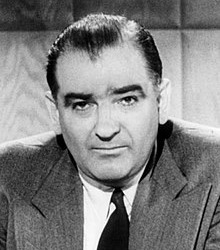
So...what’s the story behind the joke? The setup has us thinking that Rose is at first talking about Joseph McCarthy. Joseph McCarthy was best known as a politician, specifically a United States Senator representing Wisconsin. Although he was a Democrat for most of his life, he was elected to the Senate as a Republican in 1946 and began his tenure in 1947. The first three years of his Senate career were unremarkable. In February 1950, however, he shot into the national political spotlight when during a speech he gave in West Virginia, he claimed to have a list of either 205 or 57 (the exact number is disputed and no audio from the speech survives) individuals working for the State Department who were members of the United States Communist Party and referred to them as “Enemies Within”. But he had no such list. But he had attained enough political clout to order investigations into potential Communists in the United States, alleging that there were communists who had infiltrated not just the U.S. Government, but also American universities as well as the film industry. McCarthy is often lumped together with the House Un-American Activities Committee (HUAC), which began focusing its investigations on communists (when it had previously also investigated people connected to the Nazis during World War II) the same year McCarthy joined the Senate, but he never served on that committee (being that it was a House committee and McCarthy was a Senator). He also never served on the Subversive Activities Control Board (SACB), but the board was inspired by McCarthy’s fervent calls to investigate any and every person possibly associated with the Communists. These investigations led to many people, especially those in the entertainment industry, to be blacklisted for alleged connections to the Communist Party and ended up ruining a lot of reputations. Journalist Edward R. Murrow became a prominent critic of McCarthyism and devoted episodes of his series See It Now to the hearings. At the end of one episode which profiled McCarthy and the impacts of McCarthyism, Murrow said the following, which is attributed to helping to turn public opinion against McCarthy:
“We must not confuse dissent with disloyalty. We must remember always that accusation is not proof and that conviction depends upon evidence and due process of law. We will not walk in fear, one of another. We will not be driven by fear into an age of unreason, if we dig deep in our history and our doctrine, and remember that we are not descended from fearful men.”
The negative receptions came to a head when McCarthy started accusing members of the United States Army of being communists, which led to a series of Senate hearings on the matter. During one of these hearings, Joseph Welch, who was serving as Army Counsel during the hearings was told by McCarthy to look into Fred Fisher, a lawyer in Welch’s own firm, who had been a member of the National Lawyers Guild, a group that Attorney General Herbert Brownell, Jr. had accused of being the “legal bulwark of the Communist Party”. Welch had confirmed that Fisher was indeed a member of the NLG and had sent him back to his firm in Boston and replaced him with another lawyer. McCarthy continued his attacks on Fisher, and at this point, Welch stopped McCarthy cold and said the following, which ended up summing up the attitude of McCarthyism:
“Senator, may we not drop this? We know he belonged to the Lawyer's Guild ... Let us not assassinate this lad further, Senator; you've done enough. Have you no sense of decency, sir? At long last, have you left no sense of decency?”
After a last parting shot at McCarthy, Welch excluded himself from the remainder of the hearings. Later that year, on December 22, 1954, the Senate voted 67-22 to censure (formally reprimand) him, which while he was not expelled from the Senate, essentially stripped him of his committee assignments and eradicated his influence in the Senate. He remained in office until his death from hepatitis (believed to be exasperated by his alcoholism) on May 2, 1957. He was succeeded by Democrat William Proxmire, who would go on to become the longest-serving U.S. Senator from Wisconsin (he was in the Senate for about 32 years). McCarthy’s seat is currently held by Democrat Tammy Baldwin, who is notable for being the first openly LGBT Senator (Baldwin is openly lesbian), as well as the first woman to represent Wisconsin in Congress.

Now, as for Charlie McCarthy, he was a puppet character portrayed by actor and ventriloquist Edgar Bergen, who was also the father of actress Candice Bergen (best known for playing the title character of Murphy Brown). Charlie McCarthy was portrayed as a young dandy, wearing a top hat, tails, and a monocle. The height of the character’s popularity was in the 1950s, but Bergen performed with the character all the way up until a few weeks before Bergen’s September 1978 death.
(Now do you get the whole “puppet for the right wing” punchline in the joke?)
A big thank you goes out to @peanutbutterqueen who gave me the heads-up on this particular joke!
This was “Snowlessknitter Explains the Golden Girls Joke” and thank you for coming to my TED Talk! 😂
#the golden girls#snowlessknitter explains the joke#rose nylund#joseph mccarthy#charlie mccarthy#edgar bergen#episode: sisters and other strangers
9 notes
·
View notes
Photo
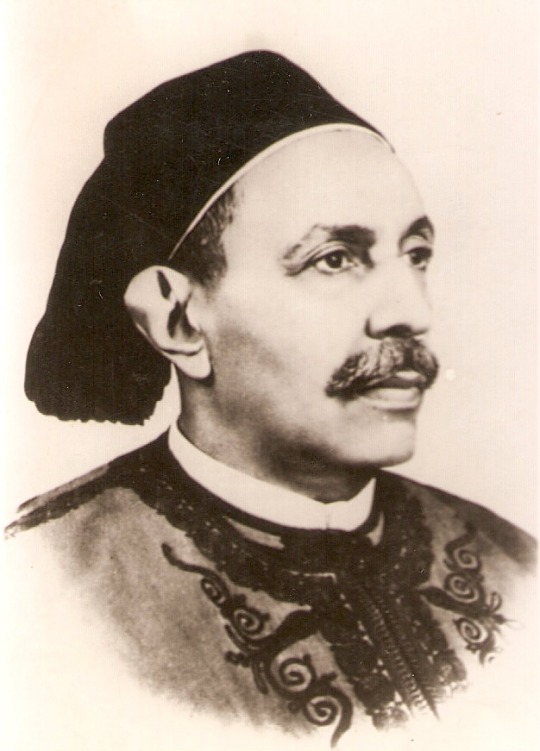
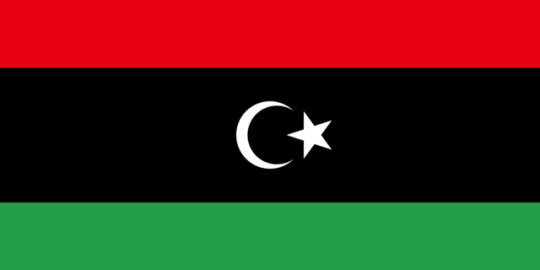
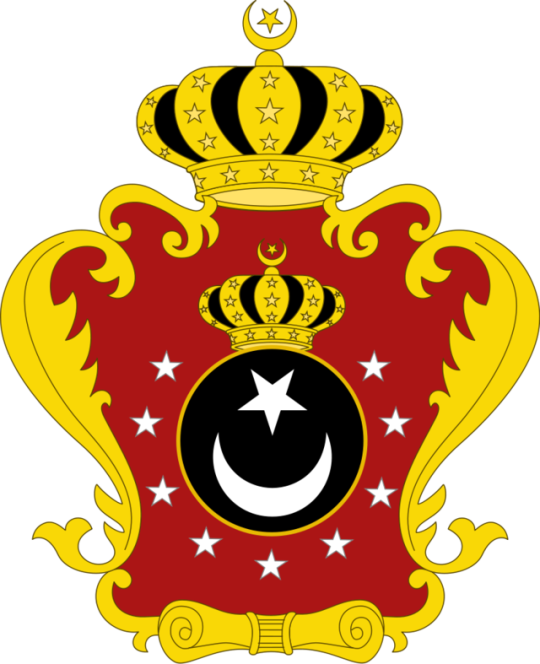
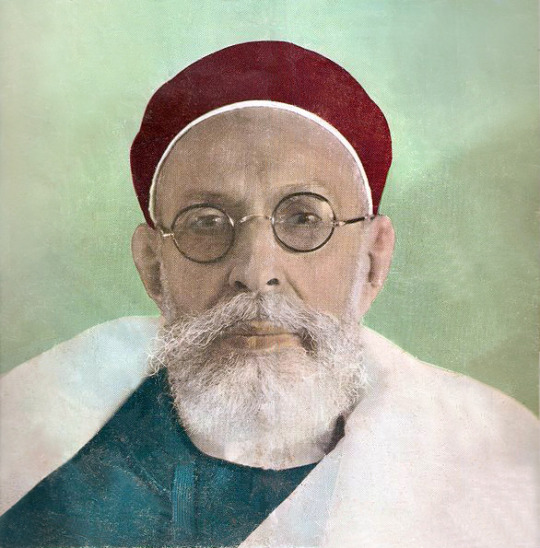
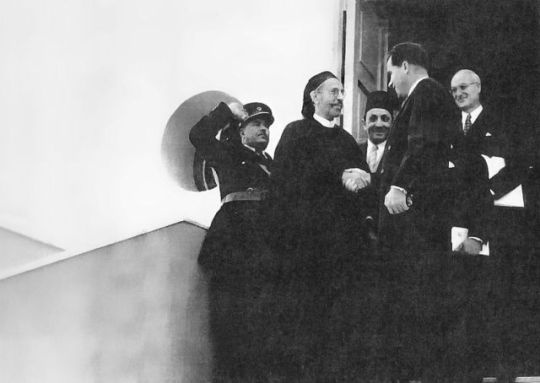

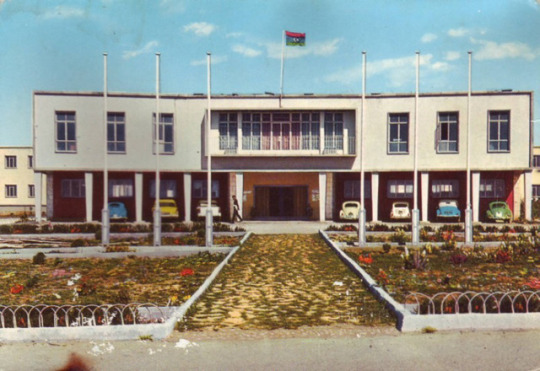
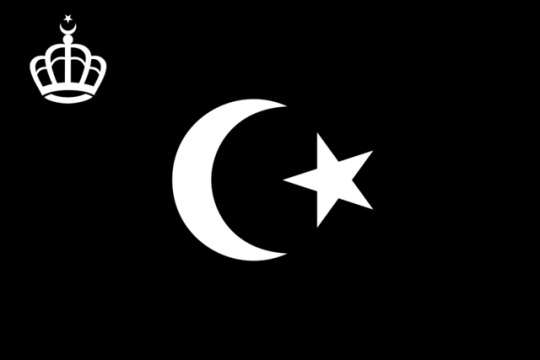


Idris (Arabic: إدريس الأول; El Sayyid Prince Muhammad Idris bin Muhammad al-Mahdi as-Senussi; 12 March 1889 – 25 May 1983),[1]was a Libyan political and religious leader who served as the Emir of Cyrenaica and then as the King of Libya from 1951 to 1969. He was the chief of the Senussi Muslim order.
Idris was born into the Senussi Order. When his cousin, Ahmed Sharif as-Senussi, abdicated as leader of the Order, Idris took his place. Cyrenaica was facing invasion from the Italians. Idris formed an alliance with the British, through whom he entered into negotiations with the Italians, resulting in two treaties; these resulted in the Italian recognition of Senussi control over most of Cyrenaica. Idris then led his Order in an unsuccessful attempt to conquer the eastern part of the Tripolitanian Republic.
Following the Second World War, the United Nations General Assembly called for Libya to be granted independence. It established the United Kingdom of Libya through the unification of Cyrenaica, Tripolitania, and Fezzan, appointing Idris to rule it as king.
On 24 December 1951 Idris announced the establishment of the United Kingdom of Libya from the al-Manar Palace in Benghazi.[28] The country had a population of approximately one million, the majority of whom were Arabs, but with Berber, Tebu, Sephardi Jewish, Greek, Turkish, and Italian minorities.[29] The newly established state faced serious problems; in 1951, Libya was one of the world's poorest countries.[30] Much of its infrastructure had been destroyed by war, it had very little trade and high unemployment, and both a 40% infant mortality rate and a 94% illiteracy rate.[25] Only 1% of Libya's land mass was arable, with another 3–4% being used for pastoral farming.[31]Although the three provinces had been united, they shared little common aspiration.[32]
According to the reporter Jonathan Bearman, Idris was "nominally a constitutional monarch" but in practice was "a spiritual leader with autocratic temporal power",[39] with Libya being a "monarchical dictatorship" rather than a constitutional monarchy or parliamentary democracy.[35] The new constitution granted Idris significant personal power,[34] and he remained a crucial player in the country's political system.[40] Idris ruled via a palace cabinet, namely his royal diwan, which contained a chef de cabinet, two deputies, and senior advisers.[35] This diwan worked in consultation with the federal government to determine the policies of the Libyan state.[35] Idris was a self-effacing devout Muslim, he refused to allow his portrait to be featured on Libyan currency and also insisted that nothing should be named after him except the Tripoli Idris Airport.[34] Idris' regime soon banned political parties from operating in the country, claiming that they exacerbated internal stability.[37] From 1952 onward, all candidates for election were government nominees.[37] In 1954, the Prime Minister Mustafa Ben Halim suggested that Libya be converted from a federal to a unitary system and that Idris be proclaimed President for Life.[41] Idris recognised that this would deal with the problems caused by federalism and would put a stop to the intrigues among the Senussi family surrounding his succession. He asked Ben Halim to produce a formal draft for these plans, but the idea was dropped amid opposition from Cyrenaican tribal chiefs.[41]
This situation changed suddenly and dramatically in June 1959 when research prospectors from Esso (later renamed Exxon) confirmed the location of major petroleum deposits at Zaltan in Cyrenaica. Further discoveries followed, and commercial development was quickly initiated by concession holders who returned 50 percent of their profits to the Libyan government in taxes. In the petroleum market, Libya's advantages lay not only in the quantity but also in the high quality of its crude product. Libya's proximity and direct linkage to Europe by sea were further marketing advantages. The discovery and exploitation of petroleum turned the vast, sparsely populated, impoverished country into an independently wealthy nation with potential for extensive development and thus constituted a major turning point in Libyan history. Libya's petroleum law, initially passed in 1955, was amended in 1961 and again in 1965 to increase the Libyan government's share of the revenues from oil.[11]
Under Idris, Libya found itself within the Western sphere of influence.[42] It became the recipient of Western expertise and aid, and by the end of 1959 it had received over $100 million of aid from the United States, being the single biggest per capita recipient of American aid.[43] U.S. companies would also play a leading role in the development of the Libyan oil industry.[44] This support was provided on a quid pro quo basis, and in return Libya granted the United States and United Kingdom usage of the Wheelus Air Base and the al-Adem Air Base.[45] This reliance on the Western nations placed Libya at odds with the growing Arab nationalist and Arab socialist sentiment across the Arab world.[44] The Arab nationalist sentiment promoted by Radio Cairo found a particularly receptive audience in Tripolitania.[46] In July 1967, anti-Western riots broke out in Tripoli and Benghazi to protest the West's support of Israel against the Arab states in the Six-Day War.[47]Many oil workers across Libya went on strike in solidarity with the Arab forces fighting Israel.[47]
The 1955 law created conditions that enabled small oil companies to drill alongside larger corporations; each concession had a low entry fee, with rents only increasing significantly after the eighth year of drilling.[50] This created a competitive atmosphere that prevented any one company from becoming crucial to the country's oil operation, although it had the downside of incentivising companies to produce as much oil as possible in as quick a period as possible.[51] Libya's oil fields fuelled rapidly growing demand in Europe,[52] and by 1967 it was supplying a third of the oil entering the West European market.[53] Within a few years, Libya had grown to become the world's fourth largest oil producer.[52] Oil production provided a huge boost to the Libyan economy; whereas the per capita annual income in 1951 had been $25–35, by 1969 it was $2000.[41] By 1961, the oil industry was exerting the greater influence over Libyan politics than any other issue.[40] In 1962, Libya joined the Organization of the Petroleum Exporting Countries (OPEC).[54] In ensuing years the Libyan state furthered its control over the industry, establishing a Ministry of Petroleum Affairs in 1963 and then the Libyan National Oil Company.[55] In 1968 they established the Libyan Petroleum Company (LIPETCO) and announced that any further concession agreements would have to be joint ventures with LIPETCO.[55]
Libya experienced rampant corruption and favouritism.[44] A number of high-profile corruption scandals impacted on the highest levels of Idris' government.[47] In June 1960 Idris issued a public letter in which he condemned this corruption, claiming that bribery and nepotism "will destroy the very existence of the state and its good reputation both at home and abroad".[56]
In April 1963 Idris abolished Libya's federal system.[57] Both the provincial legislative assemblies and the provincial judicial systems were abolished.[57] Doing so allowed him to concentrate economic and administrative planning at a centralised national level,[57] and thenceforth all taxes and oil revenues were directed straight to the central government.[57] As part of this reform, the "United Kingdom of Libya" was renamed the "Kingdom of Libya".[57] This reform was not popular among many of Libya's provinces, which saw their power curtailed.[57]According to the historian Dirk Vandewalle, this change was "the single most critical political act during the monarchy's tenure in office".[57]The reform handed far greater political power to Idris than he had held previously.[58] By the mid-1960s, Idris began to increasingly retreat from active involvement in the country's governance.[59]
On 1 September 1969, while Idris was in Turkey for medical treatment, he was deposed in a coup d'état by a group of Libyan Army officers under the leadership of Muammar Gaddafi. The monarchy was abolished and a republic proclaimed.[64] The coup pre-empted Idris's abdication and the succession of his heir the following day. From Turkey, he and the Queen traveled to Kamena Vourla, Greece, by ship and went into exile in Egypt. After the 1969 coup, Idris was put on trial in absentia in the Libyan People's Court and sentenced to death in November 1971.
Gaddafi's policies with regard to the oil industry would also be technocratic and bore many similarities with those of Idris.[67]
In 1983, at age 94, Idris died at the Sultan Palace in the district of Dokki in Cairo. He was buried at Al-Baqi' Cemetery, Medina, Saudi Arabia.
In 2013 the African Union commemorated King Idris' legacy as an African hero and the architect of Libya's independence from Italy's colonial rule in a public event.[15] In fact, Idris remains widely regarded as the father of an independent and unified Libya who led the country through its resistance to the colonial powers. As a quiet but firm ruler, he played a unifying role both in Libya, between the various strains of Islam and the plethora of Libyan tribes, and across the region.[16][17] He is remembered as "uncompromising" against his enemies, no matter the consequences of his actions.[16] The obituary posted by Associated Press in 1983 recalled that he stripped thirty members of the royal household of their privileges and rights, exiled seven princes and ruled in favor of the execution of one of his nephew who had murdered a trusted royal adviser.[16]
(Dirk) Vandewalle characterised Idris as "a scholarly individual whose entire life would be marked by a reluctance to engage in politics".[9] For Vandewalle, Idris was a "well meaning but reluctant ruler",[69] as well as "a pious, deeply religious, and self-effacing man".[34] The Libyan Prime Minister Ben Halim stated his view that "I was sure... that [Idris] sincerely wanted reform, but I knew from experience that he became hesitant when he felt that such reform would affect the interests of his entourage. He would gradually pull back until he abandoned the reform plans, moved by the whisperings of his entourage."[70]
Although the king and the crown prince died in exile and most of the younger generation of Libyans were born after the monarchy, the Senussi dynasty has enjoyed somewhat of a comeback during the 2011 Libyan civil war, especially in the dynasty's traditional stronghold of Cyrenaica. Opposition demonstrators to Colonel Gaddafi used the old tricolour flag of the monarchy, some carried portraits of the king,[18]and played the old national anthem Libya, Libya, Libya. Two of the surviving Senussi exiles were planning to return to Libya to support the protestors.
Growing support on the ground in Libya that a Constitutional monarchy based on the pre-revolutionary constitution should be reinstated as a force for stability, unity, and just governance has emerged since 2011. Libyan exiles, as well as prominent political actors and local groups, have publicly backed the reinstatement of the Senussi Monarchy under the leadership of Prince Mohammed el-Senussi as an attractive political option in Libya.[22][23]
Prince Mohammed el-Senussi has acknowledged the growing enthusiasm towards the reinstatement of the 1951 Constitution and the Constitutional Monarchy. He has consistently stressed that he would be honored to return and serve his country if the Libyan people demanded it.[23][27]
@baronofurga
#Kingdom of Libya#Libya#Libyan History#History of Libya#King Idris I#Idris of Libya#Monarchy#Monarchist#Monarch#Libyan Monarch#libyan monarchy#Absolute Monarch#Absolute Monarchy#Monarcho-Socialism#Senussi dynasty#House of Senussi
13 notes
·
View notes